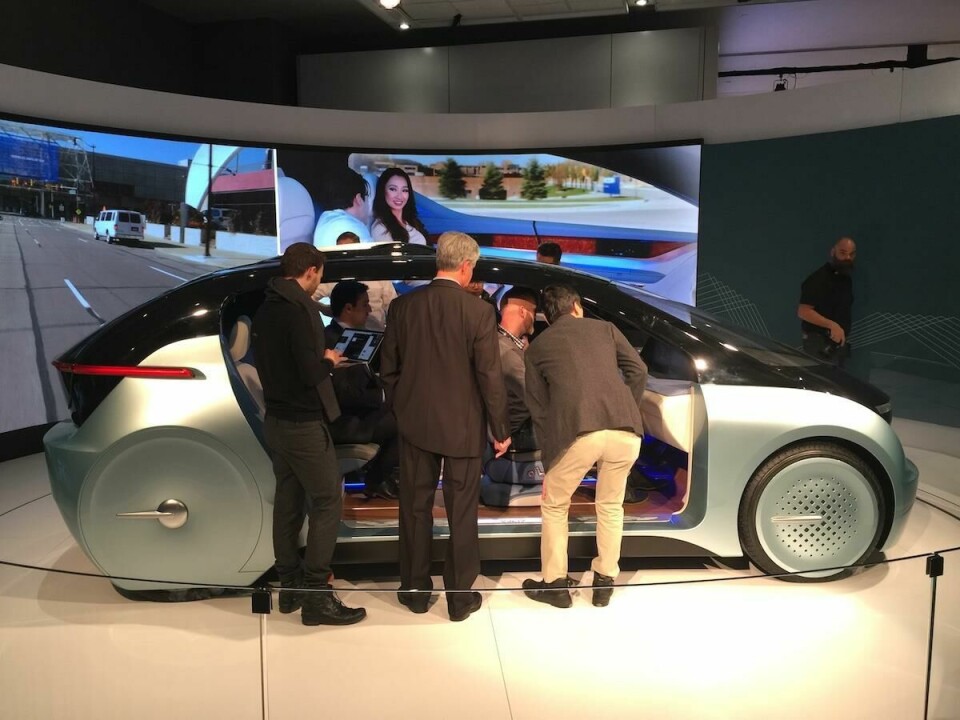
Detroit 2017: Yanfeng’s autonomous showstopper
Yanfeng wows Detroit with fully-working autonomous car interior, CDN reports from the Detroit 2017 show
Here at Car Design News we’re now used to seeing beautiful but non-functioning concept interiors from car makers or functional but far from aesthetically pleasing cut-away cabin prototypes from Tier 1 suppliers. As an antidote to both, Yanfeng’s XiM17 Level 3.5 autonomous driving concept was a pleasant surprise for considering both interior form and function so well.
Tucked away up the elevator at one end of the first floor of Detroit’s Cobo Hall, above and away from the main exhibition space full of the car makers, Yanfeng’s Tier 1 stand was nonetheless busy on both press days as various management entourages and engineering and design teams – including Chinese start-up Next EV – came to marvel at the balletic seating and floor console manoeuvres of the XiM17. So much so that on the two occasions Car Design News visited it was hard to obtain clean photos (thus the inclusion of some studio press shots in this article and associated gallery).

The XiM17 was the subject of much industry attention…
The pictures do it some justice, but the way the concept’s interior morphs from driver mode to meeting and lounge phases in real-time as you watch needs to be seen to be properly believed (so watch the company’s video too). Rear seats flip back into the trunk and then disappear as shutters smoothly envelop them (there’s luggage space in the front, due to the EV powertrain). Front seats turn inwards – or completely turn around to face rearward in the case of the passenger pew – and the floor console can slide fore and aft along the length of the cabin to keep the crucial controls where the user wants to be.

‘Lounge Mode’ – the main picture shows ‘Meeting Mode’
Principal designer Leo Schürhaus explained that the BMW X6 exterior-sized project’s maturity was down to a long two-year gestation. “It was one year of traditional research and one year of design development,” he told Car Design News on the show stand. “If you believe in autonomous vehicles and the freedom it gives us to provide this flexibility in a changeable interior then we need to assume that these vehicles will be lighter and longer to be able to give the consumer this level of experience.”
Schürhaus is particularly proud of the ‘meeting mode’ of the XiM17, adding: “What we love about this mode is that the experience is not reliant on screens alone. You’re not fully sucked in by the screen. They just provide the background. What’s fundamental to the experience is that both passengers can have an exchange, by facing each other diagonally.”

‘Meeting Mode’ seen in a press shot side view
However, he thinks the most used mode will be ‘lounge’. “We expect the vehicle to be manned by one person 80-90% of the time, so we think the ‘lounge mode’ will be the most popular of all – where the front seats move backwards and the rear seats fold into the trunk. Imagine you’re getting out of work, you’re tired, so you hit ‘lounge mode’ and go all the way home watching TV or playing a game and you don’t need to worry about traffic anymore. And the vehicle resembles your living room even before you arrive home.”
That living room is pretty high spec too, with a single integrated curved screen by Samsung up front, fold-out tray tables at the back, plus moulded leather interior door surfacing, copper accents and even diamond-pattern LEDs embedded into the cabin’s fabric walls. But the big screen isn’t touchscreen: “The reason why is because it will be too far away for many of the seating positions the interior can create,” Schürhaus continues. “The flexibility of the seating requires the floor console to be with the driver at all times. That gives neat access to all of the controls you need, including those on the IP screen. We use a digitised touchscreen on the floor console that is angled upwards for ease of use.”

The big Samsung screen
As suppliers are known for showing real prototypes rather than conceptual flights of fancy, when can the world expect Yanfeng to be ready to launch this tech with a car maker? The next generation of cars would be seem to be the answer, as Schürhaus concludes: “What the industry is communicating to the market for these type of autonomous cars is early 2020s – a 2021-25 timeline – and as a Tier 1 interiors company, when it comes to instrument panels, floor consoles and door panels we’re fully prepared to meet their needs.”
Sounds exciting, and the way Schürhaus talks, feasible too. Put a note in the diary.



